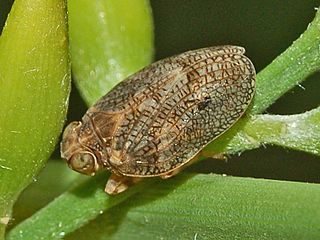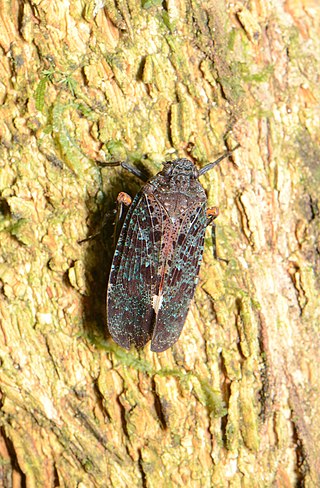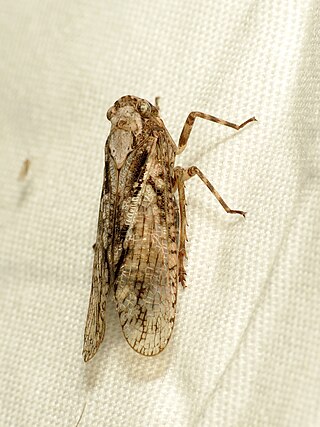
The family Fulgoridae is a large group of hemipteran insects, especially abundant and diverse in the tropics, containing over 125 genera worldwide. They are mostly of moderate to large size, many with a superficial resemblance to Lepidoptera due to their brilliant and varied coloration. Various genera and species are sometimes referred to as lanternflies or lanthorn flies, though they do not emit light.

A planthopper is any insect in the infraorder Fulgoromorpha, in the suborder Auchenorrhyncha, a group exceeding 12,500 described species worldwide. The name comes from their remarkable resemblance to leaves and other plants of their environment and that they often "hop" for quick transportation in a similar way to that of grasshoppers. However, planthoppers generally walk very slowly. Distributed worldwide, all members of this group are plant-feeders, though few are considered pests. The infraorder contains only a single superfamily, Fulgoroidea. Fulgoroids are most reliably distinguished from the other Auchenorrhyncha by two features; the bifurcate (Y-shaped) anal vein in the forewing, and the thickened, three-segmented antennae, with a generally round or egg-shaped second segment (pedicel) that bears a fine filamentous arista.

The western pond turtle, also known commonly as the Pacific pond turtle is a species of small to medium-sized turtle in the family Emydidae. The species is endemic to the western coast of the United States and Mexico, ranging from western Washington state to northern Baja California. It was formerly found in Canada, but in May 2002, the Canadian Species at Risk Act listed the Pacific pond turtle as being extirpated.

Dictyopharidae is a family of planthoppers, related to the Fulgoridae. The family comprises nearly 760 species in more than 150 genera which are grouped into two subfamilies, Dictyopharinae and Orgeriinae.

Issus coleoptratus is a species of planthopper belonging to the family Issidae.

Penthicodes is a genus of planthoppers belonging to the family Fulgoridae, subfamily Aphaeninae: found in South-East Asia. The genus name was formerly treated as feminine, but in 2022 it was revised to masculine in accordance with ICZN Article 30.1.4.4, changing the spelling of several species' names.

Calyptoproctus is a genus of planthoppers in the family Fulgoridae; records are from Central and South America.

Lycorma is a genus of planthoppers native to Asia. The first species within the genus was described by Frederick William Hope in 1843 and the genus was formally established by Carl Stål in 1863.
Cnidus is a genus of African planthoppers in the family Achilidae. There are about 19 described species in Cnidus.

Pintalia is a genus of cixiid planthoppers in the family Cixiidae. There are at least 50 described species in Pintalia.

The subfamily Poiocerinae include Hemipteran insects in the family Fulgoridae, found especially in the tropics.

Penthicodes variegatus is a species of planthoppers in the subfamily Aphaeninae (Fulgoridae): found in South-East Asia. It belongs to the subgenus EreosomaKirkaldy, 1906. The genus name was formerly treated as feminine, but in 2022 it was revised to masculine in accordance with ICZN Article 30.1.4.4, changing the spelling of this species' name from variegata to variegatus.
Penthicodes pulchellus is a species of planthoppers in the subfamily Aphaeninae (Fulgoridae): found in southern India, Indo-China and Malesia. It belongs to the subgenus EreosomaKirkaldy, 1906. The genus name was formerly treated as feminine, but in 2022 it was revised to masculine in accordance with ICZN Article 30.1.4.4, changing the spelling of this species' name from pulchella to pulchellus.

Lycorma imperialis is a planthopper indigenous to parts of China and Indo-Malaysia. L. imperialis was originally discovered in 1846 by Adam White and has one recognized non-nominate subspecies, L. i. punicea. L. imperialis has undergone a number of reclassifications since its discovery and is one of four species in the genus Lycorma. L. imperialis follows a hemimetabolous life cycle and will undergo a series of nymphal stages (instars) before maturing to an adult.
Alphina is a genus of planthoppers in the family Fulgoridae occurring in South America.

Scaralina is a genus of planthoppers in the family Fulgoridae occurring in North America and Central America, from Idaho to Panama.

Scaralis is a genus of planthoppers in the family Fulgoridae occurring in Central America and South America. The genus contains 13 species, placed into two subgenera.

Scaralina aethrinsula is a species of planthopper in the family Fulgoridae. It is found from Idaho in the United States south to the Sierra Madre Occidental in Mexico. It is one of four species that were, for several decades, erroneously grouped together under a single name, Alphina glauca; this name is now treated as a synonym of S. marmorata.
Scaralina cristata is a species of planthopper in the family Fulgoridae. It is found from Arizona in the United States south to the Sierra Madre Occidental in Mexico. It is one of four species that were, for several decades, erroneously grouped together under a single name, Alphina glauca; this name is now treated as a synonym of S. marmorata.
Scaralina marmorata is a species of planthopper in the family Fulgoridae, found throughout the southeastern United States. It is one of four species that were, for several decades, erroneously grouped together under a single name, Alphina glauca; this name is now treated as a synonym of S. marmorata.













